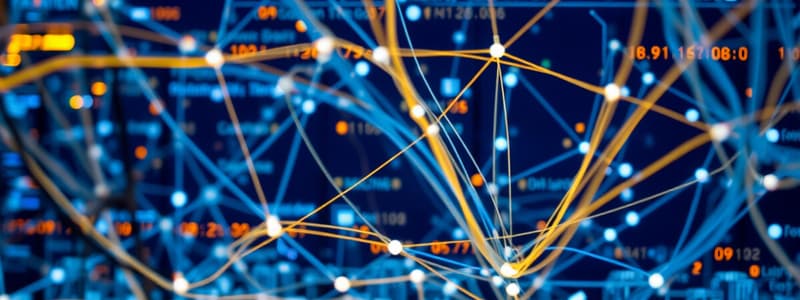Podcast
Questions and Answers
Which type of network primarily uses conventional physical cables for data transmission?
Which type of network primarily uses conventional physical cables for data transmission?
- Wireless Networks
- Cellular Networks
- Optical Networks
- Wired Networks (correct)
What is the function of network protocols?
What is the function of network protocols?
- To define hardware standards
- To enable communication between devices from different manufacturers (correct)
- To improve network speeds
- To restrict communication within a network
What type of address is a MAC address also known as?
What type of address is a MAC address also known as?
- Network Layer Address
- Internet Protocol Address
- Link-Layer Address (correct)
- Transport Layer Address
In which type of network can MAC addresses communicate directly?
In which type of network can MAC addresses communicate directly?
Which of the following devices is typically NOT found in a network?
Which of the following devices is typically NOT found in a network?
What role do switches play in a network?
What role do switches play in a network?
How does a router operate within a network?
How does a router operate within a network?
What is the primary function of an Internet Service Provider (ISP)?
What is the primary function of an Internet Service Provider (ISP)?
What characteristic distinguishes IPv4 addresses?
What characteristic distinguishes IPv4 addresses?
Which statement about IPv6 is true?
Which statement about IPv6 is true?
What is the purpose of network ports in data communication?
What is the purpose of network ports in data communication?
What does TCP ensure during data transmission?
What does TCP ensure during data transmission?
What is a key feature of an access point in a WLAN?
What is a key feature of an access point in a WLAN?
What is the maximum range of port numbers available for applications using TCP and UDP?
What is the maximum range of port numbers available for applications using TCP and UDP?
Which kind of IP address is used only within a closed network?
Which kind of IP address is used only within a closed network?
What can all routers involved in data packet forwarding potentially do?
What can all routers involved in data packet forwarding potentially do?
What do the 'privileged ports' in networking refer to?
What do the 'privileged ports' in networking refer to?
How does an ISP facilitate Internet traffic for its customers?
How does an ISP facilitate Internet traffic for its customers?
What is a unique feature of the Transmission Control Protocol (TCP)?
What is a unique feature of the Transmission Control Protocol (TCP)?
Which of the following best describes the function of User Datagram Protocol (UDP)?
Which of the following best describes the function of User Datagram Protocol (UDP)?
What is the primary role of Internet Control Message Protocol (ICMP)?
What is the primary role of Internet Control Message Protocol (ICMP)?
What is a significant advantage of using cloud computing for customers?
What is a significant advantage of using cloud computing for customers?
What does DHCP stand for and what is its primary function?
What does DHCP stand for and what is its primary function?
Which of the following is a disadvantage of cloud computing mentioned in the content?
Which of the following is a disadvantage of cloud computing mentioned in the content?
What is the role of the Domain Name System (DNS)?
What is the role of the Domain Name System (DNS)?
In the DNS hierarchy, what is the initial entry point called?
In the DNS hierarchy, what is the initial entry point called?
In which cloud computing model do customers need technical knowledge to configure servers?
In which cloud computing model do customers need technical knowledge to configure servers?
What does the cloud provider manage in the Platform as a Service (PaaS) model?
What does the cloud provider manage in the Platform as a Service (PaaS) model?
How are IP addresses associated with domain names stored in Forward-DNS?
How are IP addresses associated with domain names stored in Forward-DNS?
Which of the following statements about Software as a Service (SaaS) is accurate?
Which of the following statements about Software as a Service (SaaS) is accurate?
What is a significant feature of Reverse-DNS?
What is a significant feature of Reverse-DNS?
What is a potential risk when using cloud providers based on their geographical location?
What is a potential risk when using cloud providers based on their geographical location?
Which statement about DHCP leases is correct?
Which statement about DHCP leases is correct?
What type of record in DNS specifies the mail server for a domain?
What type of record in DNS specifies the mail server for a domain?
What should customers consider regarding the privacy of their data when using cloud computing services?
What should customers consider regarding the privacy of their data when using cloud computing services?
Which aspect of cloud computing is emphasized by its definition?
Which aspect of cloud computing is emphasized by its definition?
How do usage charges typically work in Software as a Service (SaaS)?
How do usage charges typically work in Software as a Service (SaaS)?
What is a drawback of cloud computing related to vendor dependencies?
What is a drawback of cloud computing related to vendor dependencies?
What is a primary characteristic of how cloud services are billed?
What is a primary characteristic of how cloud services are billed?
What happens in the event of errors within cloud services?
What happens in the event of errors within cloud services?
How can organizations manage their DNS naming structure?
How can organizations manage their DNS naming structure?
Which DNS record type is used for mapping a hostname to an IPv6 address?
Which DNS record type is used for mapping a hostname to an IPv6 address?
What does the term 'speaking names' refer to in the context of Forward-DNS?
What does the term 'speaking names' refer to in the context of Forward-DNS?
Flashcards are hidden until you start studying
Study Notes
Network Components
- Computer networks consist of various components utilizing different technologies and transmission media.
- Common data transmission media include:
- Wired networks
- Wireless networks (WiFi)
- Cellular networks
- Optical networks
Standards and Protocols
- Devices from different manufacturers can interact in a network.
- Protocols establish communication standards, enabling standard-compliant devices to communicate.
- Typical devices found in networks include switches, access points, and routers.
MAC Addresses / Link-Layer Addresses
- Direct data exchange is possible among devices connected in a physical network.
- Each network interface has a unique identifier known as a MAC address, which is only valid within the directly connected network.
Switches
- Switches facilitate data exchange among multiple devices connected via cables.
- Typically, a switch features 4 to 48 ports, allowing connection to various network-capable devices.
- Switches manage information about which devices are connected to which ports, forwarding data packets appropriately.
Access Points
- Access points coordinate communication within a WLAN, acting as intermediaries for devices sending packets.
- They often serve as bridges to wired networks, managing data encryption within the WLAN.
Routers
- Routers connect multiple networks, facilitating data exchange between them.
- They often have multiple network interfaces for connecting to different networks, sending packets from one network to another.
- A default router directs all outbound packets to the appropriate internet provider, while data may pass through several routers.
Internet Service Provider (ISP)
- An ISP grants end-users access to the internet, providing a default router for data transmission.
- ISPs connect to various other providers and central exchange points to route customer data traffic.
Network Protocols
- IP addresses identify specific computers within a network, ensuring that data packets reach the correct destination.
- IPv4 consists of four decimal numbers ranging from 0 to 255 (e.g., 192.168.122.1) and is nearing exhaustion, leading to the adoption of IPv6.
IPv6
- IPv6 offers a vastly larger address space than IPv4, utilizing eight blocks of hexadecimal numbers (e.g., 2001:db8::1).
- IPv6 addresses can be abbreviated for convenience.
Network Ports
- TCP and UDP protocols allow multiple applications to communicate using the same IP address by facilitating ports numbered 1 to 65536.
- Standard ports include 80 for HTTP and 443 for HTTPS, while ports below 1024 require administrative permissions.
Transmission Control Protocol (TCP)
- TCP ensures reliable data exchange between applications through continuous connection management.
- It guarantees no data loss, correct sequence delivery, and controls data flow, though at the expense of additional network traffic.
User Datagram Protocol (UDP)
- UDP allows faster, uncoordinated data exchange where packet loss is tolerated and order is not guaranteed.
- It is commonly employed in real-time applications like voice communication due to its lower overhead.
Internet Control Message Protocol (ICMP)
- ICMP conveys error messages and network status information.
- Used by commands like ping, it helps diagnose and manage network issues.
Dynamic Host Configuration Protocol (DHCP)
- DHCP automatically assigns IP addresses and configuration data to devices in a network.
- It enables devices to operate without manual configuration and manages temporary IP assignments.
Domain Name System (DNS)
- DNS acts as the "telephone book of the internet," translating human-readable names into IP addresses.
- Names are hierarchically structured, with the Root Zone and Top Level Domains (e.g., .com, .de).
DNS Records
- A-records and AAAA-records link names to IPv4 and IPv6 addresses, respectively, while MX records specify mail servers for email addresses.
- Forward DNS maps readable names to IP addresses, while Reverse DNS maps IP addresses back to names.
Cloud Computing
- Refers to on-demand access and delivery of IT services via the internet.
- Cloud providers manage infrastructure and services with automated, pay-per-use pricing.
Advantages of Cloud Computing
- Eliminates high initial costs for IT infrastructure.
- Services can scale according to demand without significant upfront investment.
- Allows clients to focus on applications rather than infrastructure.
Disadvantages of Cloud Computing
- Ongoing usage may exceed costs of maintaining in-house services.
- Pricing must be transparent and manageable.
- Potential vendor lock-in and security responsibility shift to the provider.
Cloud Computing Models
- Infrastructure as a Service (IaaS): Clients manage their servers in the cloud provider’s data centers with technical knowledge required.
- Platform as a Service (PaaS): Clients run applications on an infrastructure managed by the provider, focusing on development.
- Software as a Service (SaaS): Clients use applications provided and maintained by the provider, benefiting from automatic updates but facing potential migration challenges.
Studying That Suits You
Use AI to generate personalized quizzes and flashcards to suit your learning preferences.




